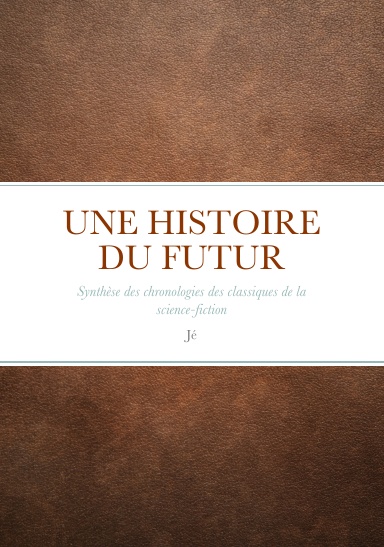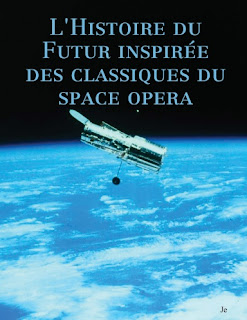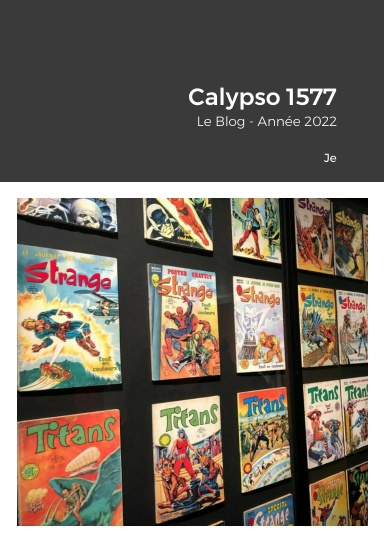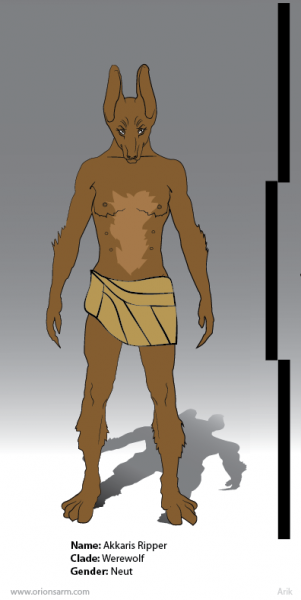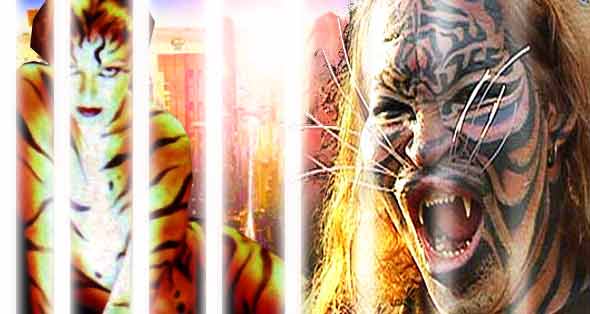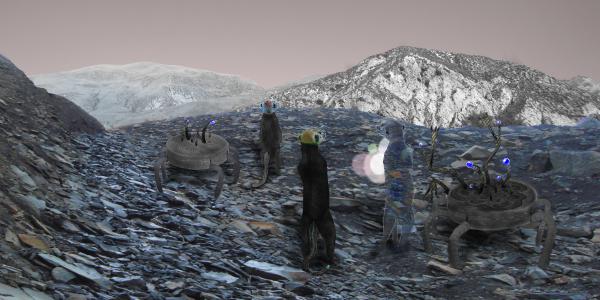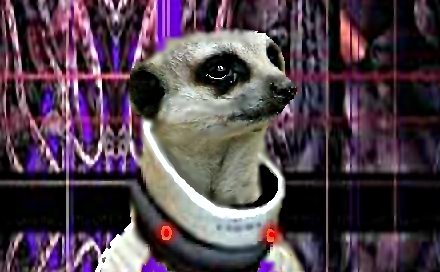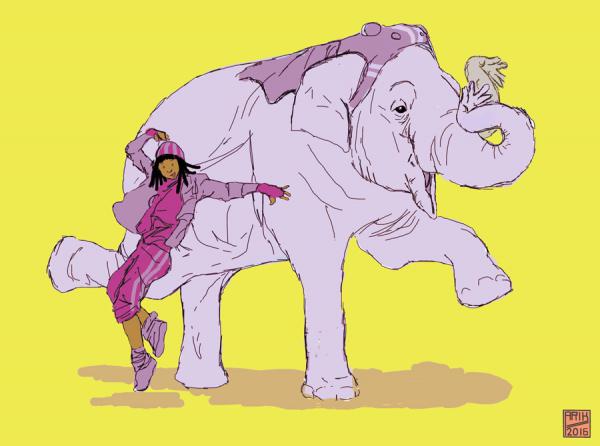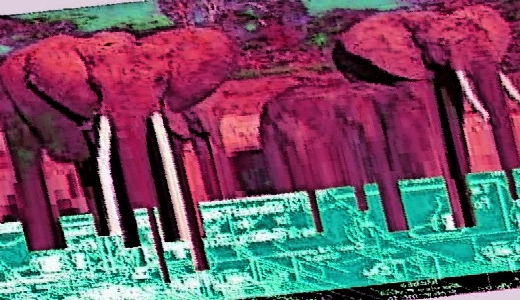The first intelligent alien race discovered by Terragens
|
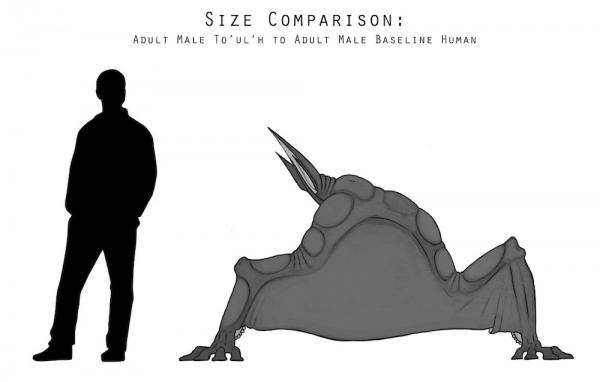
|
| To'ul'hs are a flying sophont race from the wet greenhouse world of To'ul'h Prime |
Introduction
The To'ul'hs are an intelligent, flying species with an origin on a hot
wet greenhouse world; many are now closely integrated into the
Terragen civilizations. They were the first
xenosophonts to come into direct contact with
Terragens. When they were belatedly discovered in 3831
AT
beneath the clouds of their home world they were a surprise, and in
some quarters a disappointment, because of their relatively low level of
technology.
To'ul'h Prime
(also known as Tohul) had been noted as a life-bearing world more than a
millennium beforehand, and at least one preliminary expedition to the
To'ul'h system had examined its planets from orbit, but the To'ul'h
civilization was not apparent except at closer range. Because of their
environment the To'ul'hs had never developed the kind of technology that
would have led to electromagnetic emissions or orbital settlements, and
To'ul'h cities and the extensive but subtle To'ul'h agricultural works
were not evident beneath the thick layers of clouds and airborne life of
their homeworld. The To'ul'h and their civilizations were found only
after probes were sent to the planet's surface to explore the peculiar
biology of To'ul'h Prime's pressure-cooker surface life.
Though their technologies were relatively unsophisticated (approximately equal to those of late
Agricultural Age or early
Industrial Age humans on
Old Earth)
baseline To'ul'hs had already been a civilized species for ten times as
long as the entire history of the Terragens when they were contacted.
They brought a rich culture and tradition with them when they finally
joined the rest of the Civilized Galaxy, and To'ul'hs and their
post-To'ul'h descendants are widespread and successful, some of them as a
part of Terragen civilizations and others as part of more exclusively
To'ul'h developments.
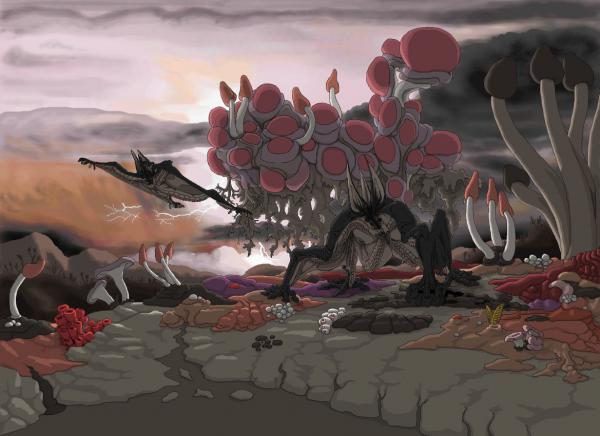
|
| Beneath
the thick clouds of Tohul Prime the surface is almost completely dark,
except when lightning briefly illuminates the landscape. |
The To'ul'h civilizations have had the greatest single xenosophont
influence on Terragen culture. To'ul'h culture, already rich, grew even
more so as the To'ul'hs and their various sophont descendants and
creations spread outward from their homeworld, and they have been in
contact with Terragens for longer than any other xenosophont group. Most
importantly, the To'ul'hs and their descendant clades have proved to be
surprisingly similar to humans and their posthuman descendants in many
aspects of their mental and cultural development despite the profound
physical differences between baseline To'ul'hs and baseline Humans. In
fact, the founding Terragen and To'ul'h species are so similar in
outlook, and had origins so close together in time and space, that
To'ul'hs have been called humanity's twin. Those same coincidences have
been the cause of much speculation by
Progenitists,
though no ancient link between Terra and To'ul'h has ever been
conclusively proven, and serious scholars dismiss these parallels as
matters of chance.
The To'ul'h homeworld, like Old Earth, was eventually commandeered by one of the
Caretaker Gods, and is now more or less as it was before Terragen contact.
Description
Though they are beautiful and graceful to the accustomed eye, To'ul'hs
have a bizarre and nightmarish appearance to Terragens who are
accustomed only to standard Old Earth life. All baseline To'ul'h are
sooty to jet black in standard Terragen vision. They mass between 40 and
100 kilograms depending on their sex and regional variety (baseline
To'ul'hs included pygmy and giant races). Typically a male To'ul'h
masses about 70 kilograms, while a female tips the scales at 63
kilograms. They are otherwise difficult to describe in terms of any
Terragen life form. They have been compared to deep-sea octopi, to
headless flying squirrels, to headless kangaroos, to skates or rays, and
even to starfish. While these descriptions are suggestive, none of them
are accurate. They are like Old Earth tetrapods in that they have a
bony skeleton, bilateral symmetry, and four limbs, but the similarity
ends there. Like the other members of their phylum, which is the
dominant form of animal life on the surface of To'ul'h Prime, they are
distantly descended from a line of sessile organisms similar in some
ways to an Old Earth crinoid. As a result they retain traces of an
ancestral tetraradial symmetry. The four limbs are attached to a central
body that harbours the vital organs. The braincase is near the centre
of the dorsal surface, and major nerve fibres radiate outwards to the
four limbs. The forelimbs are smaller and end in grasping hands, while
the hind limbs are stronger, heavier, and adapted to jumping, though
they can also grasp objects in a crude way. Both hands and feet have
eight digits: six fingers and two opposing thumbs, each ending in a
retractable claw. The digits of the feet are much stouter and less
dexterous, but either pair can grasp an object. A complex series of
folds and flaps on the upper forward part of the body is concerned with
the To'ul'h sense of hearing; the upper surface of a To'ul'h body is
otherwise smooth.
The To'ul'h digestive tract begins with a set
of sideways-opening mandibles. These are set between the forelimbs on
the ventral surface. The oral cavity has a rasping tongue, but there are
no teeth. Instead, the forepart of the stomach contains a gizzard and
gizzard stones. The main stomach and the intestines are well inside in
the central body; and the anus is on the ventral surface between the two
hind limbs. Fat is deposited around the brain and internal organs,
supplementing a rather thin and light skull. The To'ul'h excretory
system produces liquids, and has a port near the anus.
The
respiratory system is a pair of independent book-lungs between the fore
and hind limbs. Each has a spiracle that opens onto the upper body
surface. Normally air moves in and out through the spiracle on the upper
surface, but the lung is also capable of converting to a gill-like
flow-through system when a To'ul'h exerts itself, by opening slits in
the ventral surface. This "turbocharged" breathing system allows rapid
oxygen uptake and good evaporative cooling. However, a To'ul'h who
breathes in this fashion needs to drink a great deal of water. Movements
of the limbs in gliding or jumping helps pump air through the
respiratory system, whether it is working as a lung or as a gill. Most
of the sounds used in To'ul'h speech are produced by these organs. A
similar but modified gill-lung between the forward pair of limbs serves
as a "nose", and produces sounds for echolocation through a complex
series of chambers. The rear lung is largely vestigial, though it does
serve as a barometer to detect longer term pressure changes in the
atmosphere. The To'ul'h circulatory system features three hearts: one to
each lung-gill and one that circulates oxygenated blood from the
lung-gills to the rest of the body.
To'ul'hs have an organ system, comparable to the water-vascular system of
Old Earth
echinoderms, that controls a set of small manipulatory appendages on
the underside of the limbs. In the To'ul'h these allow a highly
developed set of touch and taste and are another way for them to handle
small objects. Their primitive function was to convey small items
towards the mandibles along a set of food grooves.
As in some
other representatives of their phylum, To'ul'h forelimbs contain organs
that generate and detect electrical fields in very much the same manner
as some Old Earth
electrogenic fish.
This sense is only fully operational in the water, though on land a
To'ul'h can still detect the planetary magnetic field. Under water,
however, it allows short range detection of prey that might otherwise
remain hidden, even if it is concealed beneath sediment. Ancestral
To'ul'hs used this sense to forage in streams, lakes, or tidal pools, or
in puddles and ponds of the coastal swamps. A To'ul'h can create a mild
shock with one of their electrochemical organs that is strong enough to
stun small prey items, though it does not have a significant effect on
larger organisms.
To'ul'hs have no external genitalia, but males
have testes and the equivalent of a penis at the base of each of the
arms (these have sometimes been compared to the pedipalps of Old Earth
spiders), and the openings to the female genital tracts are also found
where the arms join the body along the ventral surface. Holding hands
and sexual activity are much more strongly associated in To'ul'h than in
humans, and handholding may be a part of foreplay. The young, who are
borne live, either singly or as twins, grow until birth in the central
body cavity of the female.
Each limb has broad muscular
retractable flaps, and when fully extended, these stick together along
their edges to form a continuous surface, using the same dry adhesive
properties that Old Earth geckos use to cling to a surface. They can
also operate as pairs or completely independently of one another,
depending on the degree of manoeuvrability required. There are eyespots
along the upper dorsal surface near the brain-bulge and at the tips of
the forelimbs, but these are small and not easily distinguished from the
rest of the skin. To'ul'h skin is hard and leathery, and does not bear
discernible scales, hairs, or feathers. The upper surface is smooth and
glossy; the lower surface is rougher, with patches of dry adhesive
comparable to an Old Earth gecko's foot pads. Usually these are
associated with small projections associated with the water vascular
system, and are used by To'ul'h to cling to a surface.
Communication, Senses, and Locomotion
To'ul'h are effectively blind, but they are not insensitive to light.
Their eyespots allow them to detect sunlight, flashes of lightning, or
even the phosphorescent life forms of their native environment. However,
they cannot form images. For them, vision is a distant fifth sense.
Their primary sense is echolocation. They use a range of different
wavelengths for this purpose. Ultrasonic chirps in the 50 to 200
kilohertz range allow them to define features as small as half a
millimetre, but such signals have a very short range; less than 20
metres. They use longer wavelength sounds to sense objects and the
general terrain over longer distances, but such sounds do not provide
the same sort of fine detail. This more general echolocation sense has a
range of up to a kilometre under the right conditions. Ordinary passive
hearing is also highly sophisticated, and To'ul'hs can learn a great
deal about their environment simply by listening, without using sonar
chirps. Of course, such a sense is adapted to their native dense
atmosphere and would not be effective at Earth normal pressures. Unlike
humans, To'ul'hs have the ability to shield their ears against loud
sounds: a necessity given the dense atmosphere and frequent thunder
storms of their home world.
The second major To'ul'h sense allows
them to detect weak electrical or magnetic fields. To'ul'hs are able to
detect planetary magnetic fields, the activity of distant electrical
storms. Underwater it can detect and the bioelectrical fields of nearby
animals. This latter sense has a range of less than a metre, but they
can use it to detect small organisms that might be hidden beneath mud or
sand or inside the stalks of saprophytes. As with their sonar sense,
To'ul'hs can only use this sense by generating fields. To employ it is
to announce their presence to any being with the ability to detect such
fields.
To'ul'h touch is extremely sensitive as well, especially
in their hands and generally along the ventral surface. The palps along
their food grooves are an important source of information regarding
textures, and they also provide some information through a sense
comparable to that of taste. To'ul'h have a sharp sense of smell;
baseline To'ul'h relied heavily on this sense to discover edible
saprophytes and to track prey species.
To'ul'hs can move slowly
along the ground by walking on all fours, or somewhat more swiftly by
hopping on their hind legs. They are also good climbers in the cliffs
and in the fungal forests of their native habitats. Their hands and
foot-hands, the claws at the end of their fingers and toes, and
gecko-like pads on their ventral surface help them cling to surfaces.
However, their primary mode of rapid or long distance movement is a
series of jump-glides, supplemented by some flapping flight. They cannot
gain significant altitude, but remain within a few metres of the ground
unless they are able to use an updraft. This allows them to maintain
the equivalent of a human jog or run over considerable distances. If
local air movement is favourable, they may coast for a considerable
distance. They can "fly" underwater by trimming back the size of their
limb membranes and flapping as they do in the air, though of course they
must return to the surface to breathe. Long distance travel over and in
the water includes short bursts of swimming followed by long glides
over the water surface somewhat in the manner of an Old Earth flying
fish. The To'ul'h jump-glide depends on a high air density, or on
extremely low gravity. Some To'ul'hmorphed Terragens living at
Earth-normal temperatures and pressures have been able to accomplish the
same movements in low acceleration habs or on very small blueskyed
moons.
Lifespan and Reproduction
Despite the fact that they are so radically different in their
physiology, biochemistry, and anatomy, baseline To'ul'hs are remarkably
similar to baseline humans in their reproduction. Like humans they have
two sexes, bear their young live and usually singly (rarely as twins),
are pair bonding, and raise their young through a long period of
dependency. The male is usually, but not always, the more active partner
in courtship and as in humans is typically less discriminating
concerning potential mates or sexual partners. The females are slightly
smaller than the males, and like humans feed their young with special
secretions in early infancy and provide most of the early child care. As
with humans, males (usually the fathers of the children, or more
occasionally their uncles) typically provide additional support to the
female and infant when the child is young, and usually are involved to a
greater or lesser extent in raising and training children after infancy
as well. Childbirth is not as great a hazard for To'ul'h females as it
is for human females, but in low technology societies, pregnancy is very
inconvenient; some modes of To'ul'h locomotion such as the jump-glide
are completely unavailable in later pregnancy, even though newborn
To'ul'hs are smaller in proportion to adults than are human infants.
Likewise, a female carrying an infant who has yet to learn to jump-glide
has a very limited range. Perhaps as a result, pair bonds are even
stronger in To'ul'hs than in humans, and in most cultures the social or
legal penalties for infidelity or abandonment by either party are more
severe in proportion. A newborn weighs about one kilogram, and can crawl
from birth, though jumping comes at one year and jump-gliding is not
fully developed until the age of five years. Infants cling to the
undersides of their parents (usually the mothers) when they are very
young, or may ride on their backs when they are older but still unable
to move at adult speeds. Baseline To'ul'hs had a natural lifespan of 80
to 100 years.
Environmental Requirements
Baseline To'ul'h are accustomed to a gravity approximately 20% greater
than that of Old Earth. Their optimum environmental temperature is 135
degrees Celsius, though they can survive temperatures of 150 degrees or
more for short periods if they move slowly and have access to water so
that they can breathe heavily to cool themselves. A To'ul'h is unable to
survive without clothing and shelter at temperatures below 100 degrees
Celsius. Earthlike atmospheric pressures are immediately fatal to a
To'ul'h; their bodily fluids begin to boil away. They prefer pressures
of 70 atmospheres, though they can survive long term at as little as 50
and can tolerate shorter term exposures to pressures as low as 10. They
need oxygen, at values no less than 7% and no greater than 15%. Water on
the surface of To'ul'h is strongly acidic due to carbonic acid from the
high carbon dioxide fraction in the atmosphere and due to small
quantities of sulphuric acid from the sulphur compounds in standard
To'ul'h air. Neutral or alkaline water causes long term health problems.
Most To'ul'h can drink salty water, and excrete excess salt through
their digestive system as part of their solid wastes. The degree to
which they can do this varied originally according to regional types in
the baseline To'ul'h population, since bodies of water on the surface of
To'ul'h Prime vary from fresh to hypersaline. Like all of the life
forms native to To'ul'h Prime, To'ul'hs require considerably more
sulphur than do Terragen bionts, and small quantities of tin and mercury
are essential elements in their metabolism. To'ul'h find bright light
of any kind painful. Ultraviolet light causes severe sunburn.
Psychology
To'ul'h baselines are remarkably similar to human baselines in
psychology and in their modes of intelligence, so much so that some
Progenitist groups have suggested some ancient connection between the
two. Their similar reproductive habits have already been noted. They are
also like humans in that they were originally omnivorous foragers who
hunted or gathered in small cooperative groups and shared food within
the band along lines of kinship and mutual obligation. Like humans, they
ranged over long distances, and were largely terrestrial, but are
descended from more arboreal species. The result is that humans and
To'ul'hs understand one another rather well, and find one another almost
reassuringly predictable. However, there are significant differences.
For instance, To'ul'h are less fearful of heights as a rule (since they
can glide), and much more fearful of inclement weather. Heavy winds can
mean extreme injury in the dense atmosphere of To'ul'h Prime. The famous
"Steam Hurricanes" are particularly deadly. Not only may they tumble an
unanchored To'ul'h helplessly along the ground, breaking bones, but
they may hurl victims into the hellishly cold upper air. On rare
occasions, parcels of clear air allow sunlight to reach the surface,
blinding eyespots and even burning skin. Traditional To'ul'h cultures
always placed Hell in the skies, whereas Heaven is hot, dark, still, and
damp. To'ul'h have a love of warm water and hot springs comparable to
that of humans, though To'ul'h spas have also been compared to the baths
of the Muuh as well.
The original To'ul'h were primarily
nocturnal, though they sometimes also foraged during the day. The fact
that they are nearly blind, and that their primary sense is sonar, has
had a tremendous impact on their ways of thinking. Sound, and the
qualities of sound, are primary metaphors in To'ul'h language. So too
with their electrical sense. Because it is short range, it is an
intimate form of communication, with no good equivalent in human terms.
The
To'ul'h also have some similarities to the Muuh, perhaps because of the
fact that they both live in dim environments in which food is produced
in the upper atmosphere, and do not rely on sight. To'ul'h, for
instance, claim to understand aspects of Muuh poetry that have always
baffled humans and similar Terragens.
Like humans and like many
of the clades descended or derived from humans, the To'ul'h show a high
frequency of aggressively curious or ambitious individuals. Great
conquerors, philosophers, and artists are common, and in most To'ul'h
cultures are greatly admired. Perhaps as a result, baseline To'ul'hs had
a high rate of toposophic ascension from the very start of their
contact with Terragens, and there are many known post-To'ul'hs. Baseline
and nearbaseline To'ul'hs have shown a very human-like propensity for
aggression, both within and between societies, and their history both
before and after Terragen contact has been fully as turbulent as that of
Old Earth. Likewise, and again like Terragens, the adventurous To'ul'h
psyche has meant a strong urge to explore and colonize and an equally
strong tendency to develop into new clades.
The baseline To'ul'h
species has a natural talent and affinity for technology, similar to
that of human baselines, that under other conditions would have lead to
fairly rapidly to Industrial, Information, and Interplanetary
civilizations. As may be seen from the response of the To'ul'h to
Terragen contact, only the particulars of their situation kept the
To'ul'h from expanding beyond their planet on their own.
Society
The original set of To'ul'h societies has an extraordinary depth of
history, and was arguably much more diverse than that of Old Earth.
Advances comparable to writing, the wheel, and agriculture were achieved
tens of thousands of years before the first human civilization. Though
no one To'ul'h culture lasted more than eight or nine thousand years,
there are beliefs, technologies, traditions, and even the equivalent of
written records dating back as far as 70,000 years BT. Though they never
developed an Industrial age, the To'ul'h in the settled regions of
their planet were heirs to a culture more sophisticated and ancient than
anything experienced by Old Earth humans before the advent of
interplanetary technologies. Even tribes living the simplest and most
primitive material lives had a sense of continuity with ancient events.
The resulting diversity is impossible to describe in anything but the
most general terms.
Because of unique factors in To'ul'h history,
philosophies emphasizing balance and harmony tended to predominate over
more aggressive change-based schools of thought, but To'ul'h nature is
remarkably similar to human nature and had a startlingly similar set of
expressions. It is safe to say that nearly any school of thought or
belief ever conceived of by humans up to the end of the
Interplanetary Age
had its expression somewhere on To'ul'h Prime, sometimes more than
once. Terragen Humanists, Christians, Marxists, Taoists, Capitalists,
Etodists, Neoplatonists, Confucians, Fascists, Hindus, Negentropists,
Stoics, and many other groups have all have their cognates somewhere on
To'ul'h Prime, either among To'ul'h Prime's living cultures or somewhere
in the planet's long history. The subtle differences and the eerie
similarities between To'ul'h philosophies, religions, political
movements and their Terragen equivalents have quite understandably been a
continuing source of interest to scholars, and a continuing source of
wonder, revulsion, amusement, or controversy among partisans of these
belief systems.
To'ul'h music and art has been profoundly
influenced by their dependence on sound over sight. A development
particular to the To'ul'h is polmusic, a combination of politics,
poetry, music, logic, and rhetoric. One needs to be a To'ul'h to
experience its full persuasive force, though some Terragens (notably
some sophonts of cetacean ancestry) claim to have a grasp of its
essentials. Ancestral polmusic disciplines were widespread and ancient
on To'ul'h Prime itself, but it reached its fullest development after
Terragen contact in the Ho'mth'u culture in the Morogai system in the
late 35th century. It has since become an essential element of To'ul'h
and post-To'ul'h culture.
Another unique aspect of ancient
To'ul'h culture, still a metaphor in some traditional religions, is
ritual cannibalism. In many of the older and denser agricultural
centres, animal flesh was a rare commodity. Like humans, baseline
To'ul'hs are omnivores, and require either some meat or a careful
balance of other foods for optimum health. In many parts of the planet,
and especially in the cultures of the Narrow Seas region, this led to
ritual consumption of the dead by the kin of the deceased. The echoes of
those practices are still strong in baseline and nearbaseline To'ul'hs
whose cultures are descended from those of the great cities of the
homeworld, though of course, in the millennia since, many To'ul'h and
post-To'ul'h have forgotten the practice, and there are some homeworld
cultures (notably the nomads of the uplands) that never knew it.
To'ul'hs
do not have the usual graphic arts known to humans, except in the form
of textures and incisions on a suitable surface. Their written records
are designed to be detectable by touch or by sonar: glyphs or ideographs
carved into a surface, or runic inscriptions, or Braille-like bumps and
hollows, depending on the language and culture. Sculptures are usually
intended to be pleasing to the touch, or to give interesting patterns
when scanned with a sonar chirp.
To'ul'h of the lowlands did not
wear clothes, other than professional equipment (aprons, tool belts,
armour, etc.), though they did often wear beads, or in some cultures
decorated their skin with patterns of scars. Those of the highlands wore
protection against the cold and tended to consider it impolite or even
obscene not to enclose the main body (though arms, legs, and the flaps
between them remained free).
As an agricultural species for
nearly 100,000 years of history, the To'ul'h have an extraordinarily
deep and rich set of traditions around gardening and farming for
practical or aesthetic reasons. The shape and styles of To'ul'h gardens
varied strongly according to culture, from various pseudo-naturalistic
designs to highly abstract formal patterns, and from nearly barren
arrangements of rock and sand to lush well-watered landscapes. Though
they are designed to appeal to sonar or the sense of smell rather than
sight, and employ fungi and saprophytes in place of plants, humans find
them surprisingly pleasant to look upon, though of course To'ul'h
gardens lack any colours other than black or white or various
phosphorescent blooms, and the scents they give off tend to be
sulphurous and pleasant only to To'ul'hese life.
There are as
many styles of To'ul'h architecture as there are of human architecture,
but the To'ul'hs are much more inclined than humans to create
substantial stone or subterranean structures, or collapsible tent-like
structures, to resist or avoid the powerful but slow surface winds.
Another important difference arises from the To'ul'h ability to glide
long distances. To'ul'h generally regard upper windows and balconies as
preferred exit points from a building. Some of the most famous great
To'ul'h cities are built on cliffs or steep hillsides, or in the ravines
of the great rivers that run down from the continental plateaus. In
such places the houses of the wealthy are most often at the highest
points, since for a To'ul'h this give access to a broad region of the
lower part of a town or city; one need only launch oneself from a
suitable elevation.
A fear of the bright turbulent overworld,
with its killing chill, its lightning and thunder, and its burning
ultraviolet rays is innate in every baseline and nearbaseline To'ul'h.
Most of the planet-bound cultures believed the upper regions to be hell,
or at the least a metaphor for a hellish state. This caused
considerable fear and suspicion when the To'ul'h were first contacted by
Terragens, since they came from above.
History
Like humans, To'ul'hs lived for a long "Stone Age" as bands of foragers
who ranged within a home territory and interacted occasionally through
trade, warfare, and limited intermarriage. They were most common where
they first evolved, along the shores of the seas at the edge of
continental shelves, and on the chains of islands along the mid-ocean
ridges, where they foraged along the shores, in the "fungal"
"swamp-forests" and on the open plains of saprophytes in the upland
regions. A few invaded the harsh continental plateaus, but most of these
lived along lake shores or along the river valleys leading down to the
lowlands. These ancient To'ul'h tribes knew the use of fire (a less
potent instrument than on Old Earth due to the lower oxygen content of
the atmosphere), used pottery, wove baskets, fashioned tools from local
obsidian or from the sturdiest fungal stalks, and generally lived in a
fashion that might, with suitable translations, seem familiar to many an
Old Earth human hunter-gatherer, or for that matter to the most extreme
human Prims of modern times.
Gradually, about 100,000 years ago, the To'ul'h drifted into an
Agricultural Age.
Since many of the saprophytic life forms on the surface reproduce by
spores, not seeds, and since any one area has less reliable
productivity, and since the surface waters of To'ul'h Prime's lakes and
oceans are not especially productive, this was not a rapid process.
Archaeologists have compared this to the limited and very slow
development of agriculture-like practices in Old Earth's Australia,
where some of the same factors also applied. Nevertheless, by
approximately 95,000 years ago, the first towns and cities grew up along
To'ul'h Prime's seas and major rivers.
To'ul'h "agriculture",
rather like human agriculture, consisted largely of providing water and
organic matter, planting appropriate organisms (spores or seeds or the
gemmules of sponge-like life forms, or the larvae of sedentary
suspension-feeding animals) and removing undesirable growths and
exterminating herbivores or parasites. Likewise "pastoralism" entailed
use of herds of domesticated or semi-domesticated species, accustomed to
and bred by To'ul'h attendants. However the similarities are only
superficial. To'ul'h Prime's surface does not know seasons, but it does
know unpredictable and long-term fluctuations in local climate. Likewise
the masses of organic matter on the surface can develop in unexpected
ways, according to shifts in temperature, the nature of the rain of
nutrients from above, rainfall, and most of all interactions amongst the
saprophytic species. All of this is affected by boom and bust cycles in
the productivity of the overlying layers in the upper atmosphere, which
are themselves difficult or impossible to predict. Finally, the surface
of To'ul'h is not a source of primary production, and therefore offers a
limited output per hectare compared to the plants of a standard Gaian
world. This fundamentally less rich and reliable food supply shaped the
Agricultural Age
of the To'ul'h. Many of the longest-lived cultures survived by using
highly sophisticated management techniques and multi-species mixes,
known as polycultures, and living at relatively low settlement
densities. However, they were often outshone or overrun by shorter-lived
cultures that blossomed in favourable conditions and that crumbled
(sometimes taking more stable and potentially longer lived neighbouring
civilizations with them) when they overran the local resources or when
conditions changed. The long term effect of this has been that many of
the To'ul'h religions and philosophies have a strong component that
resembles aspects of Old Earth Taoism, Shintoism, or "Green"
Conservationism. Often these beliefs were tied to or implicit in
folkways that preserved long-term survival at the expense of short-term
development. Naturally, there were counter-movements in To'ul'h thought,
particularly in civilizations founded on a local burst of productivity.
The intermittent Skywhaler cultures are a prime example of this
phenomenon. These were widely regarded as impractical or even evil by
more traditional thinkers. This polarity between what some Terragens
have called the "Prometheans" (the advocates of progress, even reckless
progress) and the "Sysipheans" (the advocates of balance, harmony, and
persistence) eventually had its fruit in the conflicts between To'ul'h
Homeworlder and Spacer factions in the years following Terragen contact.
The
impact of agriculture on To'ul'h societies was muted, but the impact of
Industrial Age technology was even smaller. The advent of metallurgy
did not have the same result on To'ul'h as on Earth, in part because
most alloys do not survive well under humid and acidic conditions that
prevail on the surface. Metals generally were held in high regard, but
this was as much because of their odd and magical-seeming appearance to
the To'ul'h electrical sense as for their utility. Steam engines were
developed, though they were not as important because it takes a hot fire
to develop steam at all in the high pressures of To'ul'h Prime's
atmosphere. Most important of all, however, was the fact that coal, oil,
and gas deposits are practically nonexistent on the planet. The energy
subsidy that boosted the Terragens through the Industrial age and into
the
Interplanetary Age
simply did not exist. Electricity was discovered early, due to the fact
that electrical effects can be sensed directly by the To'ul'h, but it
was never highly developed. Balloons and dirigibles were an early
development based on the various floating life forms, but they never saw
widespread use, since gathering and maintaining the necessary gases
from natural floating mats, or heating the air in them from biofuels,
was expensive. Perhaps for these reasons, there never was a dramatic
onset of scientific thought, and science never became the distinct
discipline that it did on Old Earth. For instance, at the time of
contact educated To'ul'h in the most complex civilizations were aware
that their world was round and was millions of years old, and had
constructed the equivalent of a periodic table of the elements, and
could if desired build chemical batteries or internal combustion
engines, but this knowledge saw only local and specialized application.
Rail lines between the Narrow Sea's major cities were at some periods
traveled by carts that were driven by methane-powered engines, or by
oils refined from harvests of cloudforest plants taken from the high
atmosphere. Such vehicles were expensive toys of the aristocracy,
however, or the tools of elite couriers and diplomats, and never saw
broad application.
The constant rise and fall of civilizations in
To'ul'h history was not entirely a cycle of futility. Eventually a
common language (the ancestor of To'ul'hoss) and an associated
meta-culture of knowledge grew up; a way for scholars across the ages to
communicate with one another, as well as for To'ul'h traders and
diplomats from distant regions to carry out their business. This
language had the status that Sanskrit, or Latin, or the written form of
Chinese, assumed in Old Earth's human societies, but it was even more
influential and eventually became universal on To'ul'h Prime. Texts that
are thousands of years old can still be read by educated To'ul'h, and
written history in the Braille-like texts favoured by the To'ul'hoss
speakers extends back tens of thousands of years. The calendar still in
use by many To'ul'h descended clades dates back to an ancient ceremonial
calendar devised in the Narrow Seas region, many thousands of years
ago.
Terragen contact began in 3831 AT, when the famous S1
explorer Fortunate Cloud, an agent of the Mutual Progress Association,
used an exploration replicating swarm to study the biosphere of To'ul'h
Prime and found the To'ul'h civilizations that had been hidden beneath
the clouds. Long-range observations and an earlier more cursory
exploration of the system had missed the To'ul'h entirely, though of
course they had noted that To'ul'h Prime was a lifebearing world. Over a
period of 180 years, Fortunate Cloud was joined by other
representatives of the Terragens, who studied the To'ul'h and debated a
course of action. Eventually the interventionist factions prevailed, and
a carefully selected contact team was sent down to the planet surface.
In a gradual series of revelations, they introduced the most complex
civilizations of To'ul'h Prime to Terragen technologies and cultures. A
major barrier proved to be the fact that the Terragens came from the
sky. Many ordinary To'ul'h and quite a few of their greatest leaders had
the same reaction that even the most sophisticated humans might have
had if emissaries had emerged from the fiery bowels of the earth during
the
Agricultural Age.
This lingering image of the Terragens as devils, and of those who dealt
with them as corrupted by the representatives of Hell, laid the seeds
of later conflict. So too did the contrast between some of the most
dynamic Terragen memetics and that of the most sophisticated (and
successful) To'ul'h customs and beliefs.
Nevertheless, most of the To'ul'hs proved highly receptive to
human technology and ideas. Within a mere 300 years of first contacts
there were To'ul'h civilizations that had fully absorbed S<1 a="" action="" along="" already="" and="" at="" began="" begun="" both="" ceremony.="" clades="" concerning="" constructed="" course="" day.="" eill="" eithne="" emerge.="" enusian="" famous="" first="" from="" funeral="" h="" habitats="" had="" hs="" incidents="" intent="" interact="" level="" lives="" lost="" misunderstanding="" modified="" most="" o="" of="" orbiting="" own.="" post-to="" resulting="" riot="" serious="" setbacks="" several="" some="" span="" technology="" terragen="" terragens="" that="" the="" their="" there="" these="" they="" to="" transapients="" tweaks="" ul="" was="" way.="" were="" with="" xenosophont="">
<1 a="" action="" along="" already="" and="" at="" began="" begun="" both="" br="" ceremony.="" clades="" concerning="" constructed="" course="" day.="" eill="" eithne="" emerge.="" enusian="" famous="" first="" from="" funeral="" h="" habitats="" had="" hs="" incidents="" intent="" interact="" level="" lives="" lost="" misunderstanding="" modified="" most="" o="" of="" orbiting="" own.="" post-to="" resulting="" riot="" serious="" setbacks="" several="" some="" technology="" terragen="" terragens="" that="" the="" their="" there="" these="" they="" to="" transapients="" tweaks="" ul="" was="" way.="" were="" with="" xenosophont="">Over
the next millennium, To'ul'h groups became part of the human community,
settling on and To'ulhforming other Cytherean planets, modifying
themselves, building their own AIs and creating their own distinct
To'ul'h-human creole. To'ul'h-inhabited worlds existed alongside human
worlds, sometimes with no contact, sometimes with busy trade.
The
spacefaring To'ul'hs from the interstellar colonies and the To'ul'hs of
the homeworld and home system diverged more and more over this time.
The Spacers tried to help or convince the stay-at-homes to join the
greater Terragen sphere, while conservative groups in the home system,
the Homeworlders, increasingly regarded the Spacers as a menace tainted
by alien ideas and technologies. In 4211 the first To'ul'h-To'ul'h war
occurred, when a Spacer faction attempted to seize power on To'ul'h to
"administer the needs of the future". The attempt failed, but was
repeated a few decades later, leading to a brief period of technocratic
dictatorship. In 4328 the Homeworlders (with some volunteer help from a
variety of sympathetic Terragen groups) staged a bloody revolution and
ousted the Spacers.
The Spacers organized themselves and began to
plan for the final assault, which in the ordinary course of events
would have been successful. However, in 4645 one of the Caretaker Gods
made an unexpected intervention. The "god" calling eirself Smoking
Mirror (O'hoth'so'toh), declared To'ul'h eir domain; and announced e
would destroy any entity that trespassed on the
Compact of Eden
in the system. After some hothead Spacers attempted a pre-emptive
attack and Smoking Mirror dispatched them with trivial ease, the
aggressive arm of the Spacer movement lost power within the To'ul'h
sphere, and turned its energies outwards, towards exploration and
development elsewhere in the Arm.
Since then the To'ul'hs outside
of the home system have diverged into two directions. The human-creoles
have continued close interactions with humans, becoming one species
among many others (often employed to survey and colonize Cytherian or
hot Gaian worlds). Another fraction, influenced by some Homeworlder
ideas, became isolationists and refused all contact with the rest of the
civilized galaxy. It is believed they are building their own empire in
the space beyond IC6633. Some of these, though not the majority, are
known to have adopted various To'ul'h versions of Hider beliefs. As with
the Terragens proper, the To'ul'hs have many descendant cyborg,
provolve, vec, and AI clades. By policy the To'ul'h homeworld remains
accessible to any and all To'ul'hs and post-To'ul'hs, and to the sophont
universe at large, regardless of beliefs. Under Smoking Mirror's
protection, any and all belief systems are allowed in the home system,
as long as they are neither imposed on an unwilling populace nor
disruptive of the To'ul'h homeworld's ecology. It is notable that
descendants of the ancient Homeworlder ethos are dominant in the
cultures of To'ul'h Prime itself.
To'ul'h society has produced some great statesbeings, among the foremost being
Ho'th'hss'lho. Others include To'h'hshls'ho, Ho'h'h'l'l'h, H'to'hs'hssl'o, and H't'lo'h'ss'so'h.
Among
other To'ul'h persons and groups that have been influential both within
and beyond To'ul'h cultures, one particular note is the school of
Seniis-2,
which popularized the idea of Cytherean "terraformers" for many years
before the concept was finally rejected by xenopaleontologists. Today it
is of influence only to the historians of ideas, and for the part it
played in the development of early
Re-evaluation Age Progenitism.
The strong parallels between Terragen and To'ul'hese biology, the
extraordinary coincidence that both humans and To'ul'hs arose within the
same million year period, the mental similarities between To'ul'hs and
humans, and even some remarkable parallels between certain of To'ul'h
Prime's Narrow Seas cultures and some human cultures (most notably those
of Central America), and finally some enigmatic ruins, possibly a hoax,
discovered on the To'ul'h homeworld, have meant that both Terragen and
To'ul'hese clades have been susceptible to Progenitist thought, though
most educated folk reject these beliefs.
Source :
http://www.orionsarm.com/eg-topic/4802a95fb92f2

